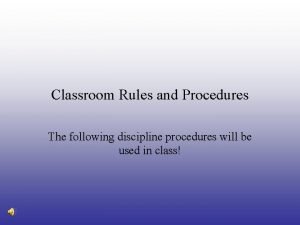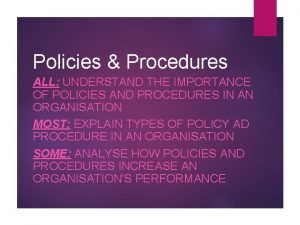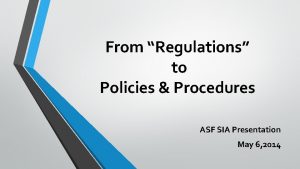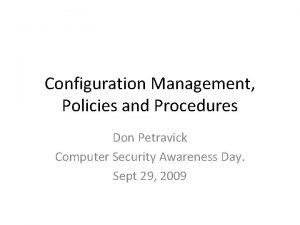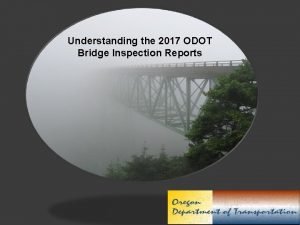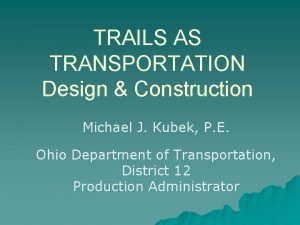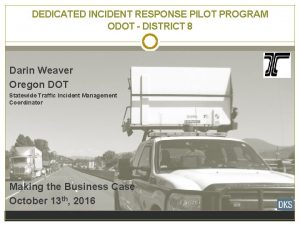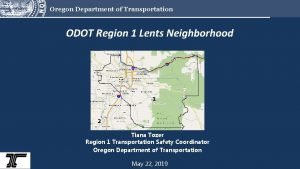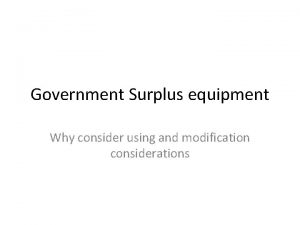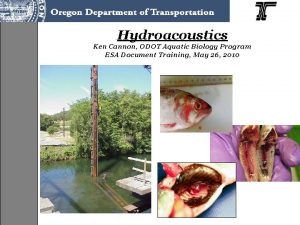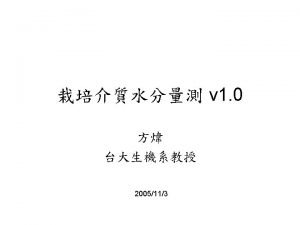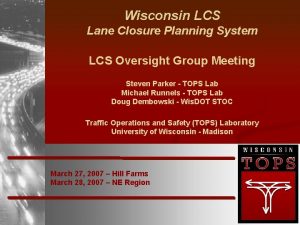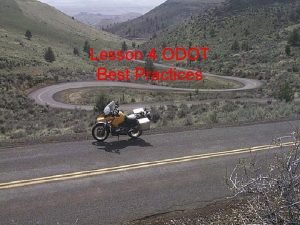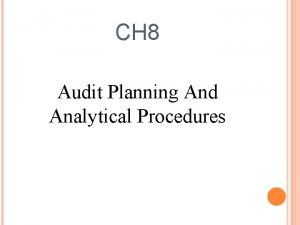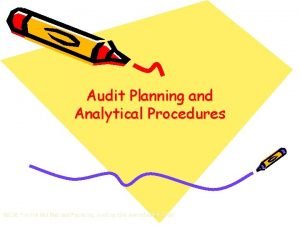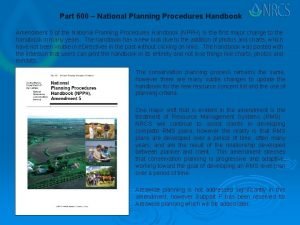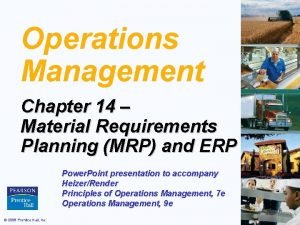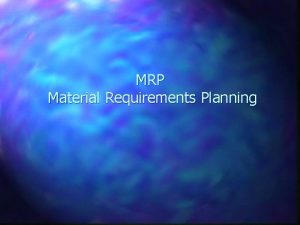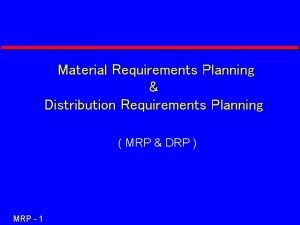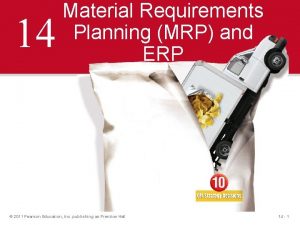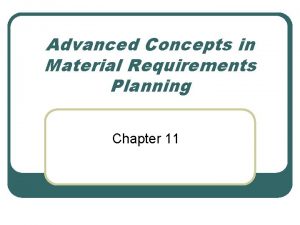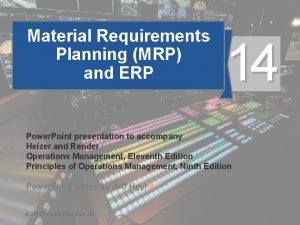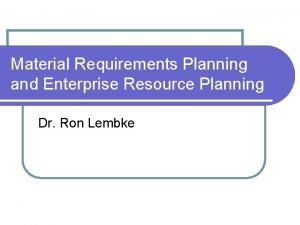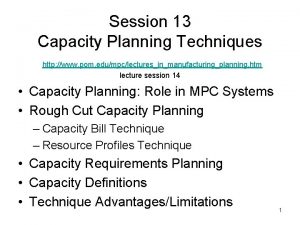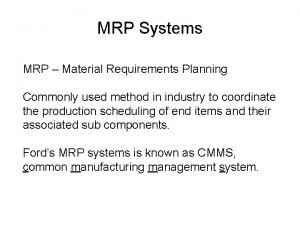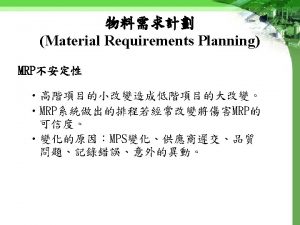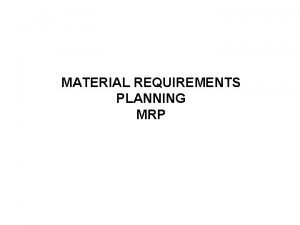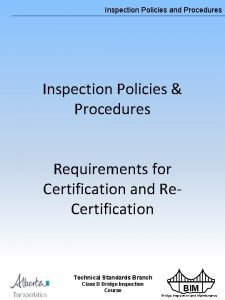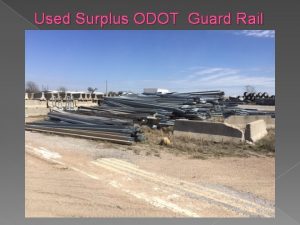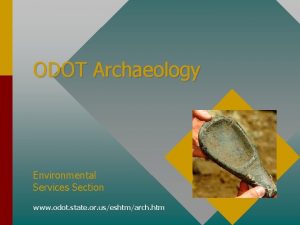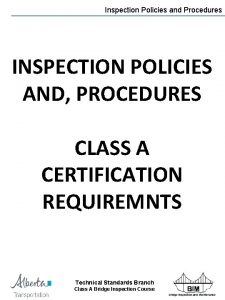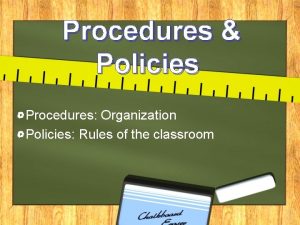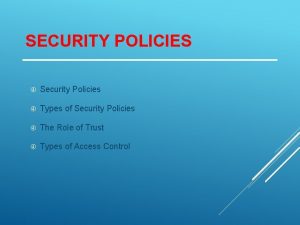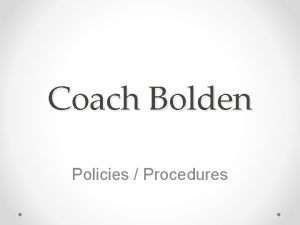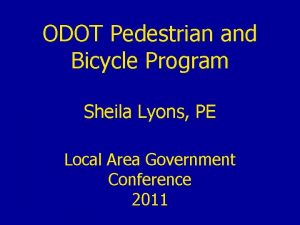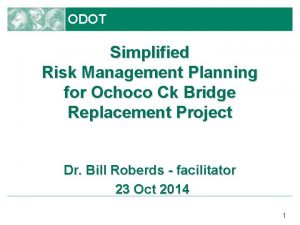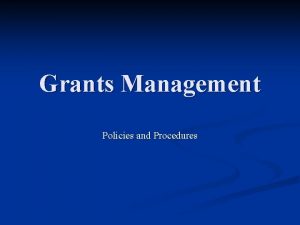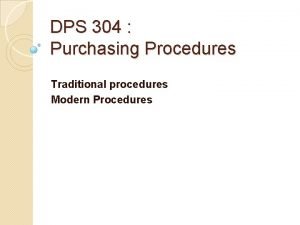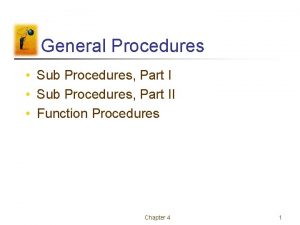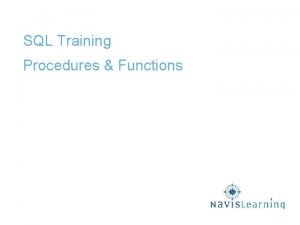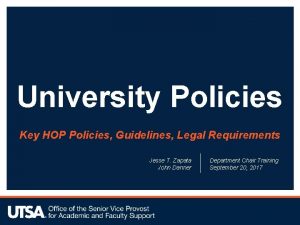The ODOT Planning Program Requirements Policies and Procedures





































- Slides: 37

The ODOT Planning Program Requirements, Policies and Procedures, Players, and Products Module 2 John de. Tar and Terry Cole March 2008

ODOT Business Cycle Planning Systems Management Development/ Design Federal, State, and Local Planning Requirements Maintenance/ Operations Construction

What Guides ODOT Transportation Planning? Statewide Planning Goals & Administrative Rules (e. g. TPR) City and County Plans and Ordinances Federal Regulations SAFETEA-LU Oregon Laws ODOT PLANNING Public Involvement/ Stakeholders ODOT Administrative Rules SAC, Access Mgmt. Oregon Transportation Plan, Highway Plan, other ODOT Plans

Requirements Federal Laws Affecting Transportation Planning • • • SAFETEA-LU (Safe, Accountable, Flexible, Efficient Transportation Equity Act) National Environmental Policy Act (NEPA) Clean Air Act Clean Water Act, particularly Section 404 Endangered Species Act Uniform Relocation Act Civil Rights Act – (Title 6, non-discrimination for race, color, or national origin) Environmental Justice Executive Order (avoid disproportionate impacts to minority or low income populations) National Marine Fisheries Act National Historic Preservation Act Section 4(f) and many more…

Requirements State Laws Affecting Transportation Planning • Transportation ü Oregon Revised Statute (ORS) 184. 618 (requirement to plan) ü Various other ORS (Title 31, Highways, Roads, Bridges, and Ferries, ORS 366 -391 • Land Use ü ORS 92 – Dividing Land (Subdivisions and Partitions) ü ORS 195 and 197 – Statewide Land Use Planning ü ORS 215 – County Planning ü ORS 227 – City Planning • Other state environmental laws ü ORS 196 – Fill and Removal Law, and Wetlands Laws

Requirements Oregon Revised Statute (ORS) 184. 618 “(1) As its primary duty, the Oregon Transportation Commission shall develop and maintain a state transportation policy and a comprehensive, long-range plan for a safe, multimodal transportation system for the state which encompasses economic efficiency, orderly economic development and environmental quality. The plan shall include, but not be limited to, aviation, highways, mass transit, pipelines, ports, rails and waterways. The plan shall be used by all agencies and officers to guide and coordinate transportation activities and to insure transportation planning utilizes the potential of all existing and developing modes of transportation. ”

Requirements Local Requirements Affect Transportation Planning • Cities and Counties: ü Are responsible for implementing the Statewide Planning Program ü Must adopt comprehensive plans, policies, and codes/ordinances that demonstrate compliance with the Statewide Planning Goals • Local planning designations and zoning determine land development and trip generation potential near state highways • Urban Growth Boundaries affect how state transportation projects are developed • Other local requirements can affect ODOT actions on plans and projects

Policies and Procedures Code of Federal Regulations (CFRs) • Federal Highway Administration (FHWA) Regulations (23 CFR) • Federal Transit Administration (FTA) Regulations (49 CFR) • Consolidated Regulations on transportation planning published February 14, 2007 • Published in the Federal Register • Define how to implement requirements for Statewide Transportation Planning and Planning in Metropolitan Planning Organizations

Policies and Procedures Statewide Planning Goals 19 Goals established as policies to guide implementation of planning laws • 1 – Citizen Involvement • 2 – Land Use Planning • 3 – Agricultural Lands • 4 – Forest Lands • 5 – Natural Resources, Scenic and Historic Areas, and Open Spaces • 6 – Air Water, and Land Resources Quality • 7 – Areas Subject to Natural Hazards • 8 – Recreational Needs • 9 – Economic Development • 10 – Housing

Policies and Procedures Statewide Planning Goals (continued) 19 Goals established as policies to guide implementation of planning laws • 11 – Public Facilities and Services • 12 – Transportation • 13 – Energy Conservation • 14 – Urbanization • 15 – Willamette River Greenway • 16 – Estuarine Resources • 17 – Coastal Shorelands • 18 – Beaches and Dunes • 19 – Ocean Resources

Policies and Procedures Statewide Planning Goals (continued) Goals that most affect Transportation Planning • 1 – Citizen Involvement • 2 – Land Use Planning • 3 – Agricultural Lands • 4 – Forest Lands • 12 – Transportation • 14 – Urbanization

Policies and Procedures Oregon Administrative Rules (OARs) • OARs interpret laws and guide their implementation • Most Statewide Planning Goals have associated OARs or some less formal guidance document • ODOT’s State Agency Coordination agreement (SAC) is implemented through OAR 731 -15 • Transportation Goal (12) is implemented through OAR 660 -12, also known as the Transportation Planning Rule (TPR) • ODOT’s Access Management Policies are implemented through OAR 734 -51

Policies and Procedures State Agency Coordination Agreement (SAC) • Is a procedure that defines how ODOT programs comply with Oregon’s statewide planning program and other laws • Was adopted in 1990 and amended 1998 • Implementation procedures are established in through OAR 731015 • Defines the ODOT Planning Program • Establishes the hierarchy of ODOT planning products • Is certified by the Land Conservation and Development Commission (LCDC)

Policies and Procedures Transportation Planning Rule (TPR) • Defines how to implement Goal 12 • First adopted in 1991 and amended in 2005 • Requires development of Transportation System Plans (TSPs) at state and local level • Provides guidance for development of State, County, City, and MPO (regional) transportation plans • Establishes that local plans must be consistent with state plans and that state projects must be consistent with local plans • Aims to improve community livability by encouraging land use patterns and transportation facilities and services that make it more convenient for people to walk, bicycle, and use transit • Also seeks to reduce reliance on single occupant vehicles (SOVs)

Policies and Procedures ODOT Policies, Standards, and Guidelines • Oregon Transportation Plan and Modal/Topic Plans (Highway Plan, etc. ) • Adopted Standards – generally contained within Modal/Topic Plans • Guideline documents (Transportation System Planning, Interchange Area Management Planning, Traffic Impact Analysis/Development Review, Design Manual, etc. ) • Operational Notices, Bulletins, Directives

Players ODOT Planning Staff • Regions ü Region Planners ü Area Planners ü Transportation Growth Management Program (TGM) ü Development Review Coordinators • Transportation Development Division (TDD) ü Long Range Policy Planners ü Transportation Planning Analysts ü Freight Mobility Specialists • Technical Services ü Environmental Project Managers

Players ODOT Planning-related Staff • Environmental Specialists • Access Management/Development Review • Transit • Rail • Bike/Ped • Freight • Preliminary Design/Roadway • ROW • Aviation

Players External Planning Staff • Metropolitan Planning Organizations (MPOs) • Area Commissions on Transportation (ACTs) • Department of Land Conservation and Development (DLCD) • Cities, Counties, MPO Staff and Portland METRO • Federal Highway Administration (FHWA) • Federal Transit Administration (FTA) • Other federal and state agencies Other Participants • General Public (Affected Businesses, Neighborhoods, Individuals) • Special Interest Groups (1000 Friends, AAA, Truckers, etc. )

Players Know your State Land Use Agency • The Land Conservation and Development Commission (LCDC) is the counterpart to the Oregon Transportation Commission (OTC) • LCDC is appointed by the Governor and approved by the Legislature • LCDC is responsible for adopting policies and rules to implement the Oregon Land Use Planning Program • The Department of Land Conservation and Development (DLCD) is the counterpart to ODOT • DLCD provides the staff support to carry out LCDC directives

Players Area Commissions on Transportation (ACTs) Created by OTC to assist with STIP and Policy Development No ACT for Portland Metro or Lane County

Players Metropolitan Planning Organizations (MPOs) Created by Federal Government to coordinate state and local transportation planning; Portland METRO also created by Oregon law Portland Metro Salem-Keizer Corvallis Eugene-Springfield Medford-Ashland Bend

Products ODOT has five basic program areas • Planning • Operations • Maintenance • Modernization • Funding

Products Key Elements of the ODOT Planning Program • ODOT’s Planning Program is carried out through a Unified Transportation Plan structure at several geographic scales: ü Transportation Policy Plan (more commonly known as the Oregon Transportation Plan or OTP) ü Modal/Topic System Plans (Highway Plan, Transit Plan, Bike and Pedestrian Plan, Aviation Plan, Passenger and Freight Rail Plans, etc. ) ü Facility Plans (Corridor, Interchange, Intersection, Downtown, etc. ) ü Project Planning (NEPA Class 1, 2, and 3 projects)

Oregon Transportation Plan Mode/Topic Plans Aviation, Bike and Pedestrian, Freight, Highway, Public Transportation, Rail, Safety System Plans MPO Regional Transportation Plans City/County Transportation System Plans State Facility Plans Interchange Area Management Access Management Expressway Support for Decision Making Management Systems Administrative Rules Guidance Documents Environmental Work Public Involvement Analysis/Modeling Modal Program Statewide Transportation Improvement Program (STIP) MPO Transportation Improvement Programs, Local Capital Improvement Programs Project Plans Solution Delivery Project Planning, Development/Construction, Operations, Maintenance, Systems Management

Products The Oregon Transportation Plan (OTP) • Is the transportation policy planning document for ODOT • 25 -year statewide multimodal policy plan • Establishes goals and policies for all system and project plans • All regional and local transportation plans must be consistent with the OTP • Updated in 2006

Products The Oregon Transportation Plan (OTP) • Has seven policy themes expressed as Goals ü Goal 1: Mobility and Accessibility v Integrated system with modal choices ü Goal 2: Management of the System v Optimize transportation system v Manage assets effectively ü Goal 3: Economic Vitality v Efficiently move people and goods v Coordinate transportation facilities and services with economis development strategies

Products The Oregon Transportation Plan (OTP) • Policy Themes (continued) ü Goal 4: Sustainability v Environmental responsibility v Energy Efficiency v Transportation and land use integration ü Goal 5: Safety and Security ü Goal 6: Funding v Develop viable funding structure v Set priorities to address different revenue possibilities ü Goal 7: Coordination, Communication, and Cooperation

Products Modal/Topic System Plans • Define system elements by mode and topic • Establish specific system element goals and policies, general system needs, improvement implementation strategies, and system performance measures and standards • Modal/Topic System Plans include: ü ü ü Oregon Highway Plan Oregon Public Transportation Plan Oregon Rail Passenger Policy and Plan Oregon Rail Freight Plan Oregon Bicycle and Pedestrian Plan Oregon Transportation Safety Action Plan

Products Oregon Highway Plan (OHP) • Is one of the modal/topic plans that implement the OTP policies, goals, and investment strategies • First adopted 1999; amendments 2000 -2007 • The OHP emphasizes: ü Efficient management of the highway system ü Increased partnerships ü Links between land use and transportation ü Access management ü Links with other transportation modes ü Environmental and scenic resources

Products Transportation Facility Plans • Provide more detailed operational, geometric, and safety analyses and solution identification plans • Apply OTP and modal plan provisions to specific situations • Provide a foundation for local plan amendments, Area Commission support and STIP development • Support subsequent environmental documentation and project development

Products Transportation Facility Plans include: • Access Management Plans (AMPs) • Commercial Center Plans • Corridor and Corridor Segment Plans • Downtown Plans • Expressway Plans • Freight Corridor Plans • Interchange Area Management Plans (IAMPs) • Intersection Plans • Safety Corridor Plans • Special Transportation Area (STA) Plans • Urban Business Area Plans

Products Other Planning Products • Specialty Plans and Studies ü Scenic Byway Corridor Management Plans ü Intelligent Transportation Systems (ITS) Plans ü Environmental Mitigation Plans ü Demand Management Plans ü Transportation Conditions Reports

Products Other Planning Products • Planning Research/Baseline Analysis ü Transportation Model Development ü Congestion Management Analyses ü Rail and Transit Feasibility Studies ü Commuter Analyses ü Statewide Model Analyses ü SPR Research Projects ü GIS/Mapping Projects • Project Plans (NEPA Environmental Documents) ü Environmental Impact Statements ü Environmental Assessments

Products City and County Transportation System Plans and Refinement Plans • City and County Transportation System Plans ü Transportation Planning Rule (TPR)-defined product ü Integrates comprehensive plan land use with transportation needs for these uses • Transportation Refinement Plans ü TPR-defined product ü Amends TSP when adopted ü Determine more specific solutions to general needs that are first identified in TSPs

Products City and County Transportation System Plans • TSPs are developed and adopted by cities and counties • ODOT participates in the development of TSPs ü Technical and Policy Stakeholder Committees ü Project and Policy Coordination ü Funding TSP development ü Validation of project funding availability

Products State and Local Plan/Project Relationship • • State Transportation Plans guide Local Plans must be consistent with State Plans State Projects must be consistent with Local Plans ODOT always works to ensure state and local plan consistency before local plans are adopted • OTC does not adopt Transportation Facility Plans until they are adopted locally or deemed consistent with local plans

Contacts John de. Tar — (541) 757 -4159 john. g. detar@odot. state. or. us Terry Cole — (503) 986 -2674 terry. d. cole@odot. state. or. us Lisa Nell — (503) 986 -4227 lisa. d. nell@odot. state. or. us
 Recruitment and induction process
Recruitment and induction process Classroom policies and procedures
Classroom policies and procedures Lending policies and procedures managing credit risk
Lending policies and procedures managing credit risk Importance of policy and procedures
Importance of policy and procedures Policies and procedures presentation
Policies and procedures presentation Configuration policies and procedures
Configuration policies and procedures Security program and policies principles and practices
Security program and policies principles and practices Security program and policies principles and practices
Security program and policies principles and practices Security program and policies principles and practices
Security program and policies principles and practices Security program and policies principles and practices
Security program and policies principles and practices Security program and policies principles and practices
Security program and policies principles and practices Odot bridge inspection manual
Odot bridge inspection manual Odot l&d volume 2
Odot l&d volume 2 Odot assetwise
Odot assetwise Postfix dovecot tutorial
Postfix dovecot tutorial Odot incident response
Odot incident response Tiana tozer
Tiana tozer Odot surplus equipment
Odot surplus equipment Odot ftp
Odot ftp Probe echo
Probe echo Lane closure system
Lane closure system Odot programmatic
Odot programmatic Audit planning and analytical procedures
Audit planning and analytical procedures Audit planning and analytical procedures
Audit planning and analytical procedures National planning procedures handbook
National planning procedures handbook Wedding planning system
Wedding planning system Closed loop mrp system
Closed loop mrp system Material requirements planning
Material requirements planning Mrp/drp
Mrp/drp Drp distribution resource planning
Drp distribution resource planning Material requirements planning concepts
Material requirements planning concepts Closed loop mrp system
Closed loop mrp system Enterprise requirements planning
Enterprise requirements planning Capacity planning techniques
Capacity planning techniques Capacity requirements planning
Capacity requirements planning Capacity requirements planning
Capacity requirements planning Material requirement planning calculation example
Material requirement planning calculation example N planning
N planning

